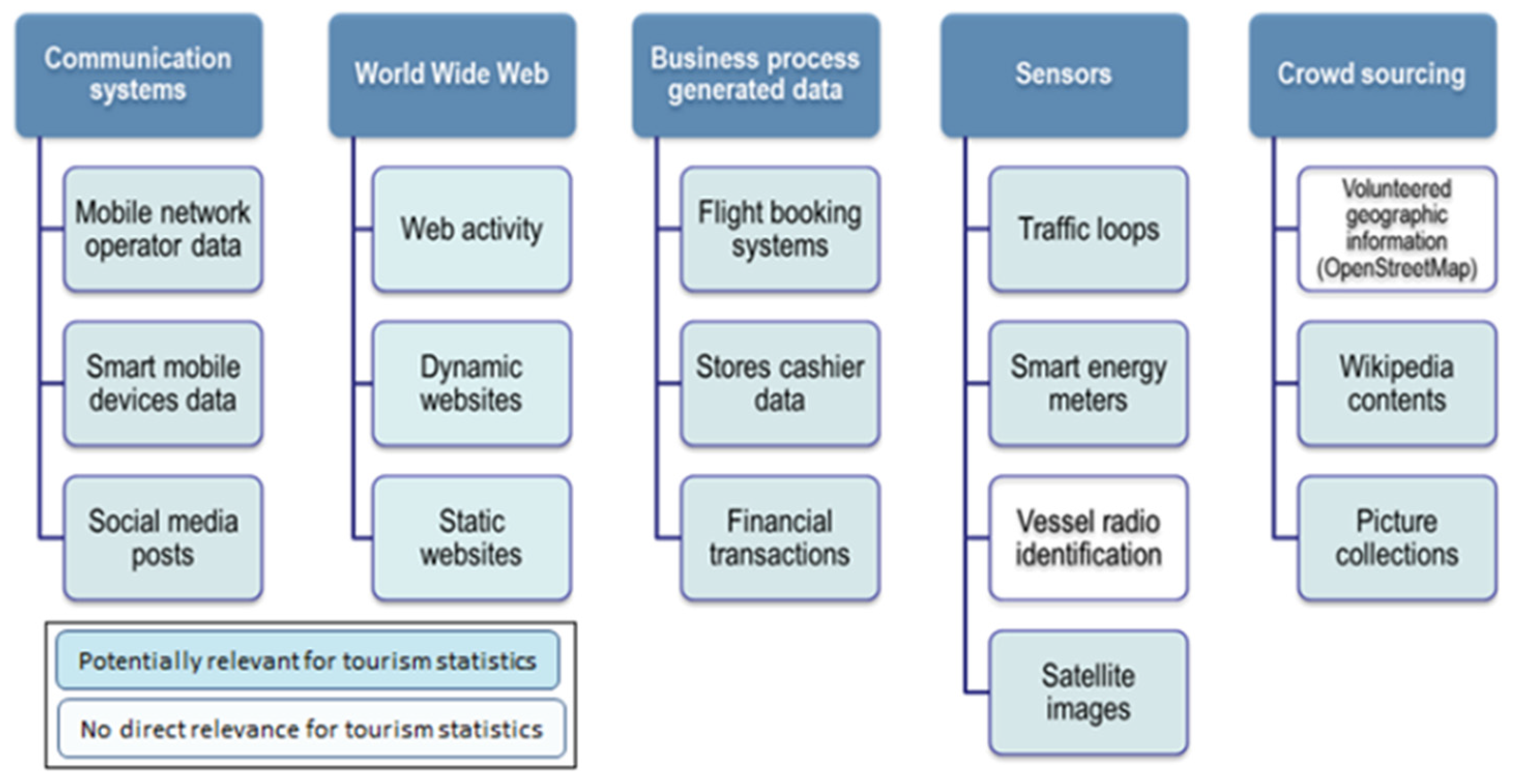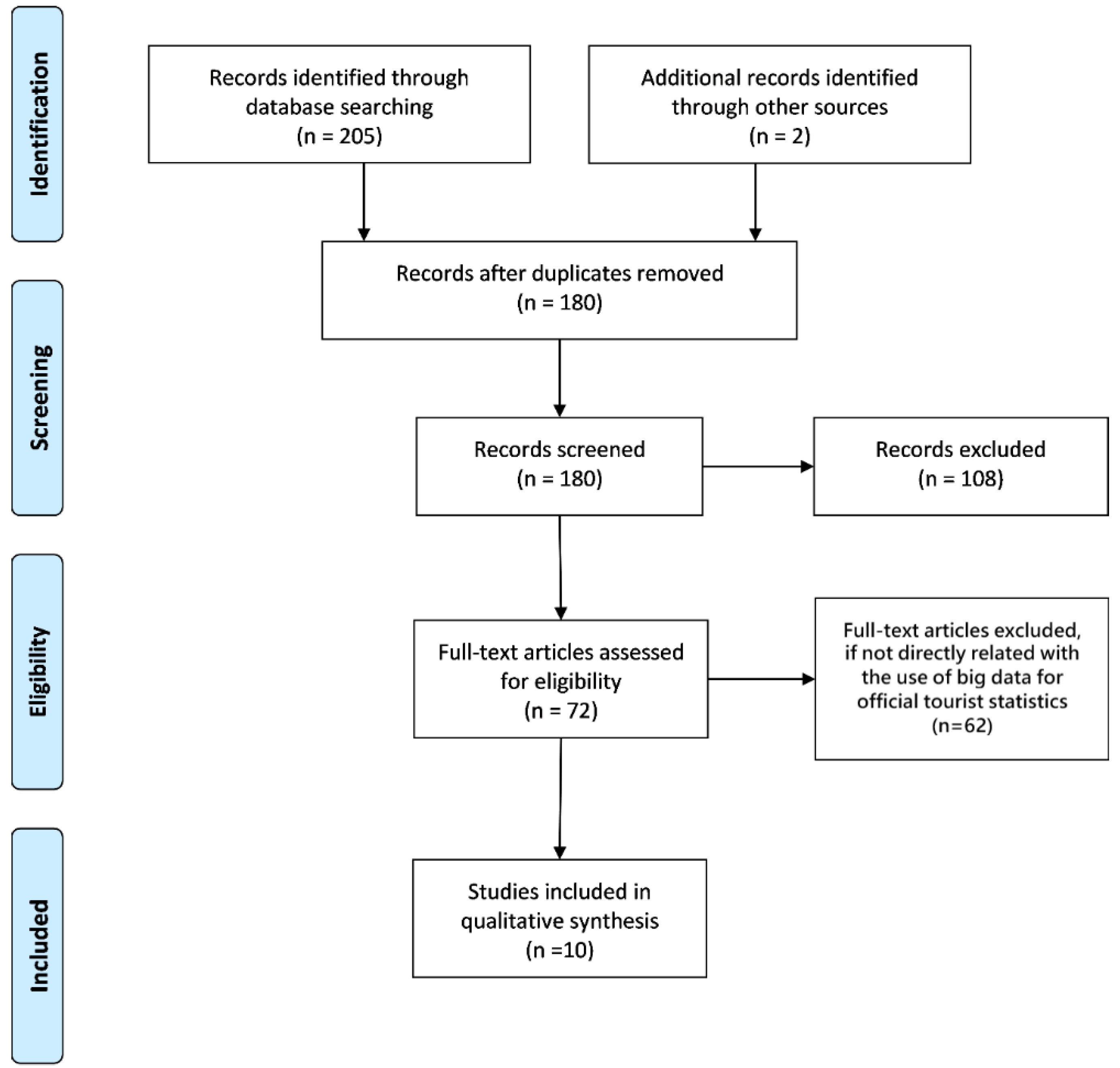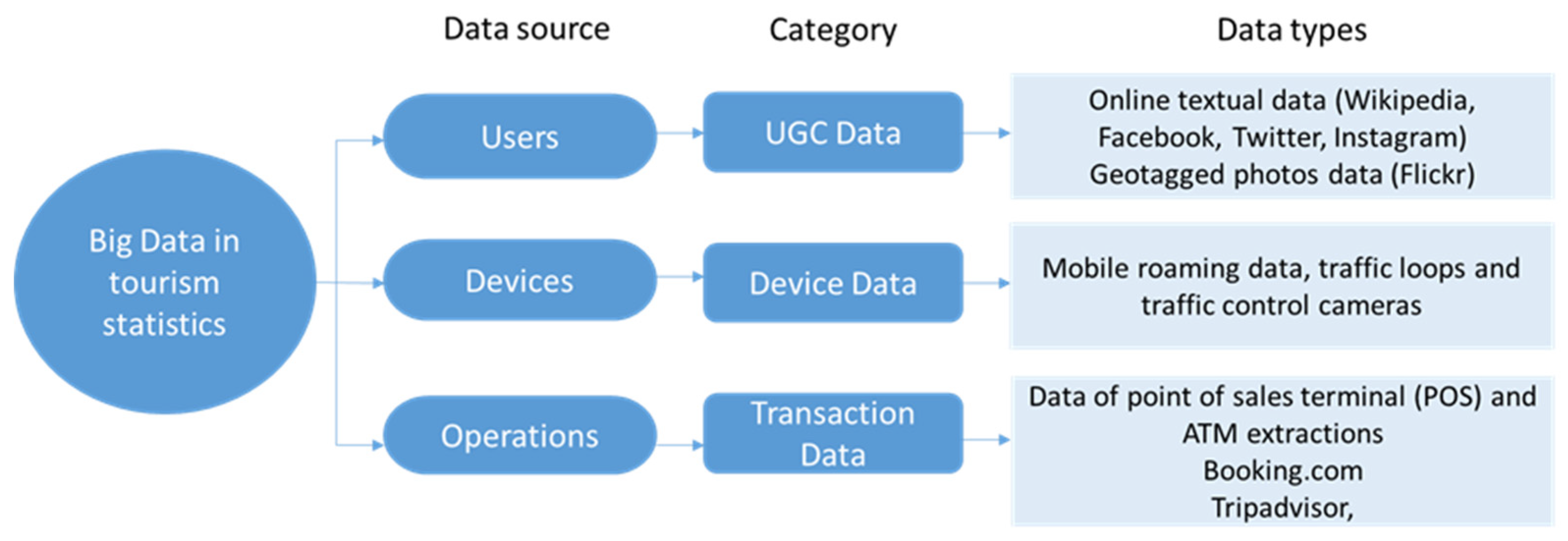Using Big Data to Measure Tourist Sustainability: Myth or Reality?
Abstract
1. Introduction
2. Literature Background
2.1. Measuring Tourism Sustainability
- Visitors: Their requirements, desires and comfort;
- Industry: The obligation for tourist companies to achieve profitability and a long-standing future;
- Community: Being respectful towards local communities in matters such as values, necessities or quality of life;
- Environment: The need to preserve physical and cultural environments, local traditions and a sense of place.
2.2. Big Data: A New Source for Official Tourist Statistics
3. Materials and Methods
- What are the motives for using big data in tourism statistics?
- What are the main types of big data used? And why are they the most used?
- Which actors are involved in studying and applying big data to generate tourism statistics? Are they implementing Tourist Information Systems?
- Which are the approaches and methodologies to use big data to measure tourism sustainability?
4. Results and Discussions
4.1. Publications on Tourism Statistics and Sustainability: General Remarks
4.2. Methodologies and Approaches: Tourism Statistics and Sustainability
4.2.1. User-Generated Content
4.2.2. Device and Transaction Data
4.3. Opportunities and Challenges in Using Big Data for Tourism Statistics
5. Conclusions
Author Contributions
Funding
Conflicts of Interest
References
- Timothy, D.J. Cultural Heritage and Tourism: An Introduction; Channel View Publications: Bristol, UK, 2011; ISBN 978-1-84541-178-7. [Google Scholar]
- Cohen-Hattab, K. Public involvement and tourism planning in a historic city: The case of the Old City of Jerusalem. J. Herit. Tour. 2013, 8, 320–336. [Google Scholar] [CrossRef]
- European Commission European Tourism Indicators System for Sustainable Destination Management. ETIS Toolkit for Sustainable Destination Management. Available online: /growth/sectors/tourism/offer/sustainable/indicators_en (accessed on 29 August 2018).
- UNWTO. Measuring Sustainable Tourism: A Call for Action–Report of the 6th International Conference on Tourism Statistics, Manila, Philippines, 21–23 June 2017 | Statistics. Available online: http://statistics.unwto.org/publication/report_philippines_intl_conf (accessed on 29 November 2018).
- Cortina, F.; Izquierdo, M.; Prado, J.; Velasco, M. Quality Implications of the Use of Big Data in Tourism Statistics: Three Exploratory Examples. In Proceedings of the European Conference on Quality in Official Statistics (Q2016), Madrid, Spain, 31 May–3 June 2016; Volume 11. [Google Scholar]
- Demunter, C. Tourism Statistics: Early Adopters of Big Data; Publications Office of the European Union: Luxemburg, 2017. [Google Scholar]
- Kzaz, L.; Dakhchoune, D.; Dahab, D.; Park, D.H.; Kim, H.K.; Carrer-Neto, W.; Hernández-Alcaraz, M.L.; Valencia-García, R.; Meehan, K.; Lunney, T.; et al. Tourism Recommender Systems: An Overview of Recommendation Approaches. Int. J. Comput. Appl. 2018, 180, 9–13. [Google Scholar] [CrossRef]
- Miah, S.J.; Vu, H.Q.; Gammack, J.; McGrath, M. A Big Data Analytics Method for Tourist Behaviour Analysis. Inf. Manag. 2017, 54, 771–785. [Google Scholar] [CrossRef]
- Del Vecchio, P.; Mele, G.; Ndou, V.; Secundo, G. Open Innovation and Social Big Data for Sustainability: Evidence from the Tourism Industry. Sustainability 2018, 10, 3215. [Google Scholar] [CrossRef]
- Chen, H.-C.; Chiang, R.H.L.; Storey, V.C. Business Intelligence and Analytics: From Big Data to Big Impact. MIS Q. 2012, 36, 1165–1188. [Google Scholar] [CrossRef]
- Fuchs, M.; Hoepken, W.; Lexhagen, M. Big data analytics for knowledge generation in tourism destinations—A case from Sweden. J. Destin. Mark. Manag. 2014, 3, 198–209. [Google Scholar] [CrossRef]
- Donovan, C.; Flaherty, E.T.; Healy, E.Q. Using big data from Wikipedia page views for official tourism statistics. Stat. J. IAOS 2017, 33, 997–1003. [Google Scholar] [CrossRef]
- UNWTO. Indicators of Sustainable Development for Tourism Destinations a Guidebook (English version) | World Tourism Organization. Available online: https://www.e-unwto.org/doi/book/10.18111/9789284407262 (accessed on 29 August 2018).
- European Association of Historic Towns and Regions. Guidelines for Sustainable Cultural Tourism in Historic Towns and Cities 2009. Available online: http://heritage.paston2.webfactional.com/wp-content/uploads/2018/09/SustainableTourismGuidelines.pdf (accessed on 29 August 2018).
- INSTO; UNWTO. International Network of Sustainable Tourism Observatories 2018. Available online: http://insto.unwto.org/ (accessed on 11 July 2019).
- European Commission. Estimular el Turismo Internacional en Europa 2010. Available online: https://eur-lex.europa.eu/legal-content/ES/TXT/HTML/?uri=LEGISSUM:et0004&from=EN (accessed on 11 July 2019).
- NECSTOUR. Barcelona Declaration “Better Places to Live, Better Places to Visit” | NECSTouR. Available online: http://www.necstour.eu/better-places-to-live-better-places-to-visit (accessed on 30 November 2018).
- Muqbil, I. Strengthening Small and Medium Sized Enterprises in the Asia-Pacific Travel & Tourism Industry. In ITB Asia, Singapore. 24 October 2008. Available online: https://www.accessibletourism.org/resources/south-asia_sme_study_imtiaz_muqbil.pdf (accessed on 29 August 2019).
- Ortiz, D.; Solo, M. Responsible and Sustainable Tourism-Lessons from LATIN America and the Caribbean; The World Bank: Washington, DC, USA, 2009; Volume 142, pp. 1–4. Available online: http://siteresources.worldbank.org/INTLACREGTOPURBDEV/Resources/EnBreve142.pdf (accessed on 11 July 2019).
- Garcia, S.M.; Staples, D.J. Sustainability reference systems and indicators for responsible marine capture fisheries: A review of concepts and elements for a set of guidelines. Mar. Freshw. Res. 2000, 51, 385–426. [Google Scholar] [CrossRef]
- Miller, G. The development of indicators for sustainable tourism: Results of a Delphi survey of tourism researchers. Tour. Manag. 2001, 22, 351–362. [Google Scholar] [CrossRef]
- Sirakaya, E.; Jamal, T.; Choi, H.S. Developing Tourism Indicators for Destination Sustainability. In The Encyclopedia of Ecotourism; CAB International: New York, NY, USA, 2001; pp. 411–432. [Google Scholar]
- Gahin, R.; Veleva, V.; Hart, M. Do Indicators Help Create Sustainable Communities? Local Environ. 2003, 8, 661–666. [Google Scholar] [CrossRef]
- Castellani, V.; Sala, S. Sustainable performance index for tourism policy development. Tour. Manag. 2010, 31, 871–880. [Google Scholar] [CrossRef]
- Tanguay, G.A.; Rajaonson, J.; Therrien, M.-C. Sustainable tourism indicators: Selection criteria for policy implementation and scientific recognition. J. Sustain. Tour. 2013, 21, 862–879. [Google Scholar] [CrossRef]
- Lozano-Oyola, M.; Blancas, F.J.; González, M.; Caballero, R. Sustainable tourism indicators as planning tools in cultural destinations. Ecol. Indic. 2012, 18, 659–675. [Google Scholar] [CrossRef]
- Torres-Delgado, A.; Palomeque, F.L. Measuring sustainable tourism at the municipal level. Ann. Tour. Res. 2014, 49, 122–137. [Google Scholar] [CrossRef]
- Fernández-Tabales, A.; Foronda-Robles, C.; Galindo-Pérez-de-Azpillaga, L.; García-López, A. Developing a system of territorial governance indicators for tourism destinations. J. Sustain. Tour. 2017, 25, 1275–1305. [Google Scholar] [CrossRef]
- Navarro Jurado, E.; Tejada Tejada, M.; Almeida García, F.; Cabello González, J.; Cortés Macías, R.; Delgado Peña, J.; Fernández Gutiérrez, F.; Gutiérrez Fernández, G.; Luque Gallego, M.; Málvarez García, G.; et al. Carrying capacity assessment for tourist destinations. Methodology for the creation of synthetic indicators applied in a coastal area. Tour. Manag. 2012, 33, 1337–1346. [Google Scholar] [CrossRef]
- OECD. Governing Regional Development Policy: The Use of Performance Indicators. Available online: http://www.oecd.org/gov/governingregionaldevelopmentpolicytheuseofperformanceindicators.htm (accessed on 13 September 2018).
- Saarinen, J. Traditions of sustainability in tourism studies. Ann. Tour. Res. 2006, 33, 1121–1140. [Google Scholar] [CrossRef]
- Dodds, R. Sustainable Tourism and Policy Implementation: Lessons from the Case of Calviá, Spain. Curr. Issues Tour. 2007, 10, 296–322. [Google Scholar] [CrossRef]
- Klein-Vielhauer, S. Framework model to assess leisure and tourism sustainability. J. Clean. Prod. 2009, 17, 447–454. [Google Scholar] [CrossRef]
- Agyeiwaah, E.; McKercher, B.; Suntikul, W. Identifying core indicators of sustainable tourism: A path forward? Tour. Manag. Perspect. 2017, 24, 26–33. [Google Scholar] [CrossRef]
- Jurigova, Z.; Lencsesova, Z. Monitoring System of Sustainable Development in Cultural and Mountain Tourism Destinations. J. Compet. 2015, 7, 35–52. [Google Scholar] [CrossRef]
- Pulido-Fernández, J.I.; Andrades-Caldito, L.; Sánchez-Rivero, M. Is sustainable tourism an obstacle to the economic performance of the tourism industry? Evidence from an international empirical study. J. Sustain. Tour. 2015, 23, 47–64. [Google Scholar] [CrossRef]
- Ruhanen, L. Progressing the Sustainability Debate: A Knowledge Management Approach to Sustainable Tourism Planning. Curr. Issues Tour. 2008, 11, 429–455. [Google Scholar] [CrossRef]
- Zeppel, H.; Beaumont, N. Climate Change and Sustainable Tourism: Carbon Mitigation by Environmentally Certified Tourism Enterprises. Tour. Rev. Int. 2014, 17, 161–177. [Google Scholar] [CrossRef]
- Vardarlier, P.; Silahtaroglu, G. Gossip Management at Universities using Big Data Warehouse Model Integrated with a Decision Support System. Int. J. Res. Bus. Soc. Sci. 2147–4478 2016, 5, 1–14. [Google Scholar] [CrossRef]
- Buhalis, P.D.; Amaranggana, A.; Buhalis, D.; Amaranggana, A. Smart Tourism Destinations Enhancing Tourism Experience through Personalisation of Services. In Information and Communication Technologies in Tourism 2015; Tussyadiah, I., Inversini, A., Eds.; ENTER 2015 Proceedings: Lugano, Switzerland; Springer: Wien, Austria, 2014; pp. 377–390. ISBN 9783319143422. [Google Scholar]
- Buhalis, D.; Foerste, M. SoCoMo marketing for travel and tourism: Empowering co-creation of value. J. Dest. Mark. Manag. 2015, 4, 151–161. [Google Scholar]
- Albino, V.; Berardi, U.; Dangelico, R.M. Smart Cities: Definitions, Dimensions, Performance, and Initiatives. J. Urban. Technol. 2015, 22, 3–21. [Google Scholar] [CrossRef]
- Boes, K.; Buhalis, D.; Inversini, A. Smart tourism destinations: Ecosystems for tourism destination competitiveness. Int. J. Tour. Cities 2016, 2, 108–124. [Google Scholar] [CrossRef]
- Gretzel, U.; Sigala, M.; Xiang, Z.; Koo, C. Smart tourism: Foundations and developments. Electron. Mark. 2015, 25, 179–188. [Google Scholar] [CrossRef]
- Gretzel, U. Intelligent systems in tourism: A Social Science Perspective. Ann. Tour. Res. 2011, 38, 757–779. [Google Scholar] [CrossRef]
- Ali, A.; Frew, A.J. Information and Communication Technologies for Sustainable Tourism; Routledge: London, UK, 2013. [Google Scholar]
- Bibri, S.E.; Krogstie, J. Smart sustainable cities of the future: An extensive interdisciplinary literature review. Sustain. Cities Soc. 2017, 31, 183–212. [Google Scholar] [CrossRef]
- Ahvenniemi, H.; Huovila, A.; Pinto-Seppä, I.; Airaksinen, M. What are the differences between sustainable and smart cities? Cities 2017, 60, 234–245. [Google Scholar] [CrossRef]
- Haarstad, H. Constructing the sustainable city: Examining the role of sustainability in the ‘smart city’ discourse. J. Environ. Policy Plan. 2017, 19, 423–437. [Google Scholar] [CrossRef]
- Perles Ribes, J.F.; Ramón-Rodríguez, A.B. Calp, hacia la sostenibilidad a través de la inteligencia. In Congresos-Seminario Destinos Turisticos Inteligentes 2017-Libro de Actas; Vera-Rebollo, J.F., Ivars-Baidal, J., Celdrán Bernabéu, M.A., Eds.; Servicio de Publicaciones de la UA: Alicante, España, 2017; pp. 71–95. [Google Scholar]
- Perles, R.J.F.; Ivars, J. Smart sustainability: A new perspective in the sustainable tourism debate. Investig. Reg. 2018, 42, 151–170. [Google Scholar]
- Gössling, S. Tourism, information technologies and sustainability: An exploratory review. J. Sustain. Tour. 2017, 25, 1024–1041. [Google Scholar] [CrossRef]
- Batista e Silva, F.; Herrera, M.A.M.; Rosina, K.; Barranco, R.R.; Freire, S.; Schiavina, M. Analysing spatiotemporal patterns of tourism in Europe at High-Resolution with conventional and big data sources. Tour. Manag. 2018, 68, 101–115. [Google Scholar] [CrossRef]
- Salas-Olmedo, M.H.; Moya-Gómez, B.; García-Palomares, J.C.; Gutiérrez, J. Tourists’ digital footprint in cities: Comparing Big Data sources. Tour. Manag. 2018, 66, 13–25. [Google Scholar] [CrossRef]
- Buhalis, D. eTourism Information Technology for Strategic Tourism Management; Financial Times Prentice Hall: Harlow, UK, 2003. [Google Scholar]
- Benckendorff, P.; Sheldon, P.; Fasenmaier, D. Tourism Information Technology; CABI: Oxford, UK, 2014. [Google Scholar]
- SEGITTUR. Tourist Intelligence System. 2018. Available online: https://www.segittur.es/es/proyectos/proyecto-detalle/Sistema-de-Inteligencia-Turstica-/#.XaCIvUYzZPb (accessed on 11 July 2019).
- Ali, A.; Frew, A.J. Technology innovation and applications in sustainable destination development. Inf. Technol. Tour. 2014, 14, 265–290. [Google Scholar] [CrossRef]
- Gomm, R. Social Research Methodology. A Criticial Introduction; Palgrave: Basingstoke, UK, 2008. [Google Scholar]
- Petticrew, M.; Roberts, H. Systematic Reviews in the Social Sciences: A Practical Guide. Available online: https://www.wiley.com/en-es/Systematic+Reviews+in+the+Social+Sciences%3A+A+Practical+Guide-p-9781405121101 (accessed on 4 September 2018).
- Denyer, D.; Tranfield, D. Producing a systematic review. In The Sage Handbook of Organizational Research Methods; Sage Publications Ltd: Thousand Oaks, CA, USA, 2009; pp. 671–689. ISBN 978-1-4129-3118-2. [Google Scholar]
- Moher, D.; Liberati, A.; Tetzlaff, J.; Altman, D.G. The PRISMA Group Preferred Reporting Items for Systematic Reviews and Meta-Analyses: The PRISMA Statement. PLoS Med. 2009, 6, e1000097. [Google Scholar] [CrossRef]
- Antonio, N.; de Almeida, A.M.; Nunes, L.; Batista, F.; Ribeiro, R. Hotel online reviews: Creating a multi-source aggregated index. Int. J. Contemp. Hosp. Manag. 2018, 30, 3574–3591. [Google Scholar] [CrossRef]
- Raun, J.; Ahas, R.; Tiru, M. Measuring tourism destinations using mobile tracking data. Tour. Manag. 2016, 57, 202–212. [Google Scholar] [CrossRef]
- Scharl, A.; Lalicic, L.; Önder, I. Tourism Intelligence and Visual Media Analytics for Destination Management Organizations. In Analytics in Smart Tourism Design: Concepts and Methods; Xiang, Z., Fesenmaier, D.R., Eds.; Tourism on the Verge; Springer International Publishing: Cham, Switzerland, 2017; pp. 165–178. ISBN 978-3-319-44263-1. [Google Scholar]
- Peng, X.; Huang, Z. A Novel Popular Tourist Attraction Discovering Approach Based on Geo-Tagged Social Media Big Data. ISPRS Int. J. Geo-Inf. 2017, 6, 216. [Google Scholar] [CrossRef]
- Li, J.; Xu, L.; Tang, L.; Wang, S.; Li, L. Big data in tourism research: A literature review. Tour. Manag. 2018, 68, 301–323. [Google Scholar] [CrossRef]
- Barrera, D.; Castillo, A.L.; Azevedo, E.M. Tourist use of historic cities: Review of international agreements and literature. Int. Humanit. Stud. 2014, 1, 1–11. [Google Scholar]
- Coccossis, H. Carrying capacity as a tool for the management of tourism pressures on heritage sites. In Extended Abstracts of the International Colloquium Visitor Management and Carrying Capacity at World Heritage Sites in China; Mogao Grottoes: Dunhuang, China, 2013; pp. 35–38. [Google Scholar]
- Xiaory, Y.; Fang, H.; Kaixuan, S. Tourist capacity management and control at west lake cultural landscape. In Extended Abstracts of the International Colloquium Visitor Management and Carrying Capacity at World Heritage Sites in China; Mogao Grottoes: Dunhuang, China, 2013; pp. 120–124. [Google Scholar]
- Massiani, J.; Santoro, G. The relevance of the concept of capacitt for the management of a tourist destinatio: Theory and application to tourism management in Venice. Riv. Ital. Econ. Demogr. E Stat. 2012, 66, 141–156. [Google Scholar]
- Reddy, M.V.; Wilkes, K. Tourism in the Green Economy, 1st ed.; Routledge: London, UK, 2017; ISBN 978-1-138-09563-2. [Google Scholar]
- Wall, G. Sustainable tourism futures: Perspectives on systems, restructuring and innovations edited by Stefan Gössling, C. Michael Hall, and David, B. Weaver. Can. Geogr. Géographe Can. 2012, 56, 150–151. [Google Scholar] [CrossRef]
- United Nation Environment Web Intelligence. Available online: http://unep.ecoresearch.net (accessed on 22 July 2019).
- Scharl, A.; Herring, D.; Rafelsberger, W.; Hubmann-Haidvogel, A.; Kamolov, R.; Fischl, D.; Fols, M.; Weichselbraun, A. Semantic Systems and Visual Tools to Support Environmental Communication. IEEE Syst. J. 2017, 11, 762–771. [Google Scholar] [CrossRef]
- Wirthmann, A.; Stavropoulos, P.; Petrakos, M. Proposal for an Accreditation Procedure for Big Data, Paper for the NTTS2015 (New Techniques and Technologies in Statistics). Available online: https://ec.europa.eu/eurostat/cros/system/files/Wirthman-etal%20Accreditation%20unblinded%20abstract_20150122.pdf 2014 (accessed on 11 July 2019).
- Pérez-Guilarte, Y.; Pazos Otón, M. Spatial Data Infrastructures in Santiago de Compostela. In Proceedings of the New Metropolitan Perspectives; Calabrò, F., Della Spina, L., Bevilacqua, C., Eds.; Springer International Publishing: Cham, Switzerland, 2019; pp. 12–20. [Google Scholar]






| Authors and Years of Publication | Title | Journal or Editorial |
|---|---|---|
| Fuchs, Höpken and Lexhagen (2014) | Bigdata analytics for knowledge generation in tourism destinations—A case from Sweden | Journal of Destination Marketing & Management |
| Raun, Ahas, and Tiru (2016) | Measuring tourism destinations using mobile tracking data | Tourism Management |
| Cortina, Izquierdo, Prado and Velasco (2016) | Quality implications of the use of big data in tourism statistics: three exploratory examples | European Conference on Quality in Official Statistics |
| Miah, Huy, Gammack and McGrath (2017) | A Big Data Analytics Method for Tourist Behaviour Analysis | Information & Management |
| Peng and Huang (2017) | A Novel Popular Tourist Attraction Discovering Approach Based on Geo-Tagged Social Media Big Data | ISPRS International Journal of Geo-Information |
| Scharl, Lalicic and Onder (2017) | Tourism Intelligence and Visual Media Analytics for Destination Management Organizations | Springer |
| Demunter (2017) | Tourism statistics: Early adopters of big data? | Publications Office of the European Union |
| Donovan, Flaherty and Healy (2017) | Using big data from Wikipedia page views for official tourism statistics | Statistical Journal of the IAOS |
| Batista e Silva, Herrera, Rosina, Barranco, Freire and Schiavina (2018) | Analysing spatiotemporal patterns of tourism in Europe at high-resolution with conventional and big data sources | Tourism Management |
| Del Vecchio, Mele, Ndou and Secundo (2018) | Open Innovation and Social Big Data for Sustainability: Evidence from the Tourism Industry | Sustainability |
© 2019 by the authors. Licensee MDPI, Basel, Switzerland. This article is an open access article distributed under the terms and conditions of the Creative Commons Attribution (CC BY) license (http://creativecommons.org/licenses/by/4.0/).
Share and Cite
Pérez Guilarte, Y.; Barreiro Quintáns, D. Using Big Data to Measure Tourist Sustainability: Myth or Reality? Sustainability 2019, 11, 5641. https://doi.org/10.3390/su11205641
Pérez Guilarte Y, Barreiro Quintáns D. Using Big Data to Measure Tourist Sustainability: Myth or Reality? Sustainability. 2019; 11(20):5641. https://doi.org/10.3390/su11205641
Chicago/Turabian StylePérez Guilarte, Yamilé, and Daniel Barreiro Quintáns. 2019. "Using Big Data to Measure Tourist Sustainability: Myth or Reality?" Sustainability 11, no. 20: 5641. https://doi.org/10.3390/su11205641
APA StylePérez Guilarte, Y., & Barreiro Quintáns, D. (2019). Using Big Data to Measure Tourist Sustainability: Myth or Reality? Sustainability, 11(20), 5641. https://doi.org/10.3390/su11205641






